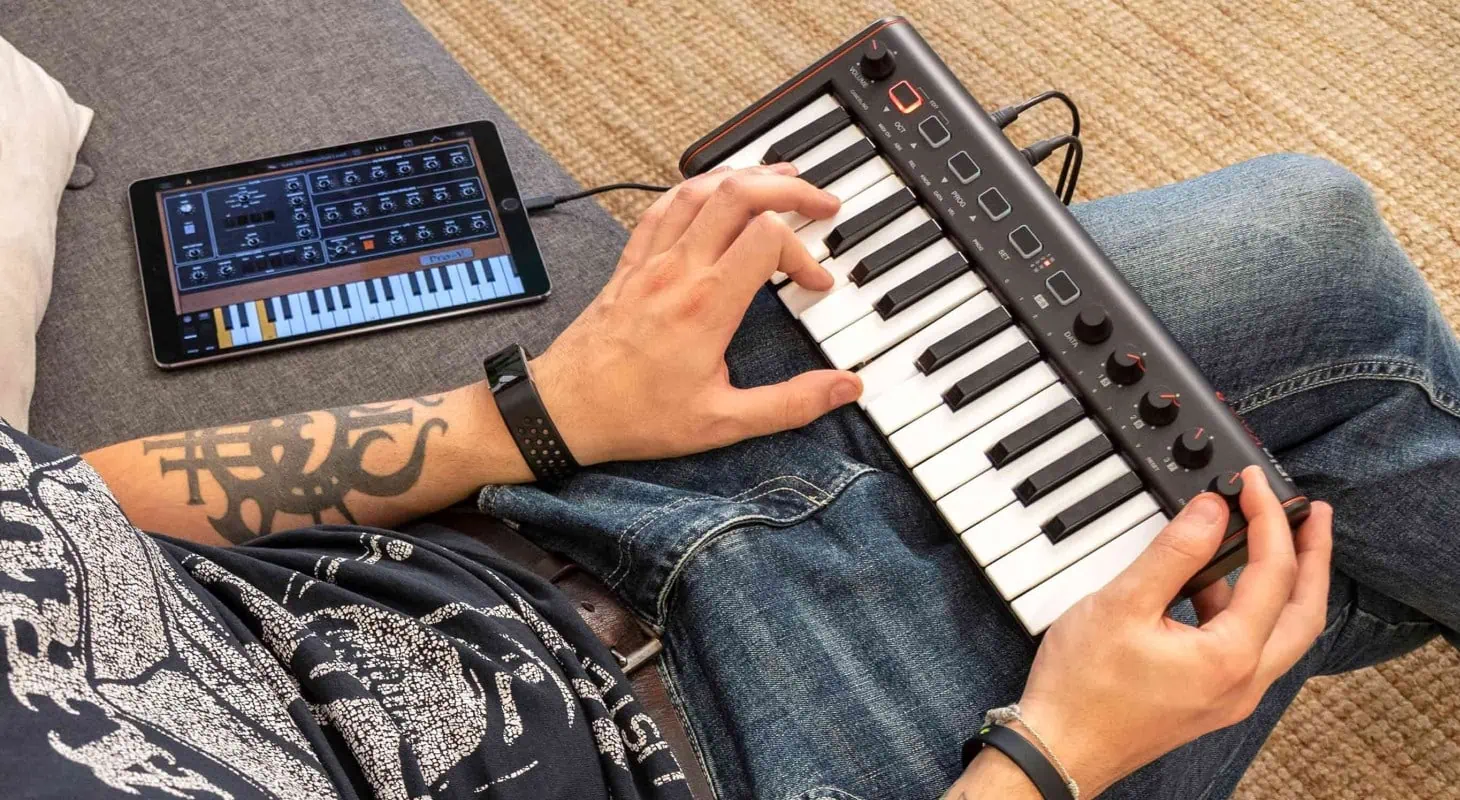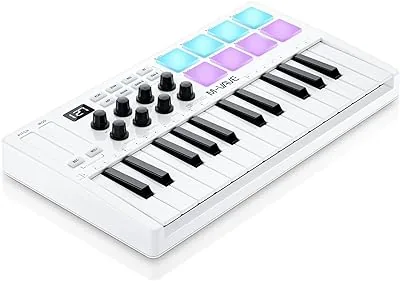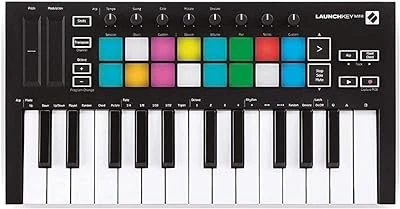I still remember when the iPad first came out with GarageBand included. At first, I was super excited, but then I thought, "How can this work without a legitimate pro MIDI controller?" However, fast forward to today, and the iPad is one of my all-time favorite tools for creating music.
I've come up with countless beats and songs while on planes, at the doctor's office, and even on jury duty!
The iPad is a dream come true for musical ideas. Since you can now use Logic and GarageBand together, it's the quickest way to arrange any idea that pops into your head.
And get this, You can even read sheet music scores and record your voice memos straight into tons of different apps. This is a songwriter's paradise.
These days, the controllers for the iPad are diverse and getting better.
Let's check out the best controllers and keyboards currently available for the iPad.
The Best iPad MIDI Controllers
1. iRig Keys 2 Pro
IK Multimedia has always been ahead of the game. I still remember when they came out with the iRig, a tiny device used for recording instrument ideas.
Although it was mainly for guitars, I could plug in other instruments and easily capture my ideas. While it wasn't the best-sounding device, it was still pretty cool.
Now, they've launched the iRig Keys 2 Pro, which is perfect for the iPad. Having a controller that's not too large when setting up with an iPad is important, so you can center the device and have quick access to the touch interface.
The knobs are perfectly centered, allowing you to tweak parameters with one hand and adjust things on the screen with the other. I still use GarageBand frequently because it's so simple and fast.
The other day, I was going through some film score sheet music on the iPad, and I had iRig Keys and GarageBand open at the same time. I was able to check that all the parts were correct, and it was unbelievably productive during my airline trip to and from the scoring stage.
Another great feature is the headphone output on this controller. It serves as a sound interface for the iPad, which is genius.
It was always awkward to listen to pro music apps through either Bluetooth or the device's built-in speakers, which aren’t ideal.
The only thing I wish they had included was a small screen to provide value information.
2. M-Wave
The M-Wave 25-key controller is seriously impressive. It's like a mashup of something Arturia would make and a bit of that Native Instruments Kontrol series vibe, but with backlit pads.
Anyone who knows me knows how much I need drum pads on my controllers, and this one is a sweet addition.
I'm always making beats on the fly, especially with my iPad because it's so fun to just mess around and create little loops. The pads could be better, but at least they're there and still better than just playing on the keys.
Plus, they added touch strips for CC control and modulation, which are essential for keyboard playing because they give you that extra expression. I also use them a lot for filter sweeps and synth editing on some of the Moog apps.
This keyboard is perfect for use with Logic on my iPad Pro. That's how I use it, and I've actually produced over 50% of my tracks before even stepping foot in the studio. The Apple M1 and M2 silicon chips have really taken iOS to the next level.
This little keyboard has everything you need, including a sustain pedal and even a headphone out. My complaint about the iRig Keys has been addressed because they added a display, which makes total sense.
M-Wave and similar companies manufacture their products in China. Although the quality has improved, it still falls short compared to more professional brands due to build and feel issues rather than defects. Nonetheless, M-Wave's product is still useful, which is why it made it onto this list.
3. Korg microKEY Air
The Korg microKEY Air is the largest keyboard controller on this list, almost like a full-on studio laptop. It's not specifically an iPad controller, but it works great with the iPad, which is why I included it on this list.
One thing I really love about Korg is the feel of their keys, so the natural touch on the 49 keys is great. However, they use mini keys to keep it slim, which I find pretty annoying.
As a drum programmer, my issue with many keys is that they're not fast enough in their reaction time, especially when playing hi-hats properly, especially at fast tempos. If you're going to use mini keys, I highly suggest adding pads like the M-Wave has.
Korg kept this controller pretty austere. It's similar to the M-Audio key station, with great feeling keys, good build quality, modulation, pitch wheel, and a sustain and USB port. No frills, nothing fancy, just a reliable controller for your iPad.
I use the Micro Key a lot when I'm setting up hotel room musical idea hubs. As a keyboard player, I just can't get comfortable with only 37 keys. This one is the perfect blend of slim build and practical use.
I've also seen many DJs use the microKEY and iPad Pro together behind the scenes of the turntable set up live. A few months ago, I actually got up on stage at a party here in LA and played the Minimoog app with the Micro Key, and it was a blast!
4. CME Xkey Air
CME creates keyboard controllers that are as sleek as Aston Martin cars. They look super cool, modern, and are still practical.
Every time I go through TSA security at airports, CME stuff triggers an extra scan because they look like weapons. They are like a block of brushed metal that can be a little scary when you put them in your backpack and go through security.
I discovered CME at Perfect Circuit in LA, which is an amazing store that sells a lot of gear for electronic musicians and composers. The CME Xkey Air is so small that it's perfect for trying out different sounds on your iPad. It's the ultimate combo for those long flights.
Honestly, I thought I would hate it because the keys aren't traditional keyboard keys but elevated touch strips. But they're not too bad, and with some practice, you can play chords and do some basic programming.
If you're going to be doing drums or programming any percussive elements, I wouldn't recommend this controller. Go for the M-Wave instead. But if you just want quick access to musical software on your iPad, nothing is easier and quicker than using the CME Xkey Air. I might call it the best micro iOS controller.
I also use this controller when inputting or checking musical scores in recording studios. It's a breeze to place on any surface, including mixing boards.
One thing to note: big studio engineers won't be too thrilled if you put a keyboard controller on the mixing board. But the CME can rest on your lap because it's so thin.
5. Novation Launchkey Mini MK3
In my opinion, the Launchkey Mini MK3 is the ultimate iPad controller. Scratch that, it's the best iOS MIDI controller out there, period. The backlit drum pads are phenomenal, and there are 16 of them!
It also has touch strips and knobs for changing values. Plus, since it's made by Novation, you know it's built with quality.
It's worth keeping in mind that it has mini keys and is relatively small. However, I don't need 25 keys for my purposes, and the size is perfect when using it with the iPad.
Having one hand free for touchscreen purposes is key, and the other hand can stay close enough to the iPad to make quick switches.
Although the mini keys aren't my favorite for programming, Novation added a Synth action feature that makes them bounce faster than other mini keys. This makes this little guy a great drum programming controller as well.
I use it with Ableton Live on both my iPad and laptop. The backlit pads are perfect for using Ableton clips that are color-matched. Even though Ableton isn't available for the iPad Pro yet, this keyboard still works flawlessly with Logic, another great DAW for the iPad Pro.
They added an ARP (arpeggiator) button and a well-laid-out transport on the right-hand side. It's stacked with features, my friends.
The only thing they didn't add is a headphone out, which some other controllers have. It's a small bummer, but not a deal-breaker for me.
Choosing the Right iPad MIDI Controller

There is a major myth that the iPad cannot handle music production or songwriting for professionals. However, many producers on forums do not seem to understand how powerful iOS apps can be. They are not the same as the DAW versions on laptops, but that is not the point.
The iPad is more than just a beat-making machine; it is a tool for capturing ideas. These controllers add a lot of functionality, especially for hands-on musicians.
But how do you know which controller is right for you? First, consider what you want out of your iPad production setup. Do you just want to mess around with it while waiting in airport lounges, or are you planning on using serious apps like Logic and GarageBand?
If you are going all-in and want to use the iPad as an extension of your studio, there are three major factors to consider when choosing the right controller.
Size
Okay, so when you're picking out a controller for your iPad, one of the most important factors is how big it is. Remember, the whole point of the iPad is that it's supposed to be easy to use wherever you are, so you want your controller to be the same way.
Now, if you're someone who needs a lot of keys - like a real keyboard player - then you might want to go for a 49-key controller. But for most of us, the smaller the controller, the better it is for the iPad.
Also, you can do a lot of cool stuff with the touchscreen on the iPad, like drawing MIDI notes and doing automation rides with your finger. This is especially helpful when you have a smaller controller since it might not have all the features you need.
Features
If you're into making music on your iPad, you might prefer making beats over creating full tracks. If that's the case, consider getting a controller with drum pads. Trust me, nothing beats the feel of those pads and the MPC-style programming.
It'll also make your percussion programming faster and more precise, which is always a plus.
Hip-hop producers have been using their iPads to create loops and samples in their free time. With a drum pad controller, you can take your skills to the next level and create beats that are truly unique.
Headphone Out
So here's the thing: Last but not least, check if the device has a headphone output. It's a small detail that people tend to overlook, but trust me, it's super important! Especially with the iPad, being limited to Bluetooth is kind of a dealbreaker for me.
I don't think Bluetooth headphones are quite up to par with some of the more professional wired headphone brands yet. And if I'm already making compromises to make music on the go with the iPad, I at least want to hear it through the best possible monitoring.
Therefore, this feature is actually kind of a big deal and narrows down the field quite a bit, you know?
Since the iPad is often used in noisy environments, it's important to pair it with high-quality, noise-isolating headphones. Whether you're on a plane, in a DJ booth, on a noisy subway, or sitting in a café, you'll need professional headphones to fully enjoy your iPad setup.
If you are interested in learning more about the best headphones for this setup, check out an article I wrote comparing some of the top headphones available.
Final Thoughts
As a producer and beatmaker, I have always dreamed of having a battery-powered MPC with keys. Nowadays, mobile MPCs are available, but they still lack those keys.
However, I have stopped limiting myself in the name of workflow and use any tools at my disposal to write music whenever I'm inspired.
Nothing beats the iOS platform, especially the iPad, for immediate convenience. I even use my Apple Watch to record vocal ideas.
Since it instantly syncs to my iPad voice memos, I just drag the ideas into a session and start chopping up parts.
It is absolutely one of the coolest ways to work. Then I layer beats with the pads and chords, and if I love it, I'll resample the vocal parts and put them on pads to go even deeper.
When I get back to my studio, I just share the session and start mixing.
Isn't that just the dream setup?






